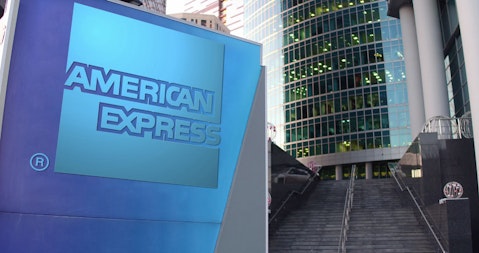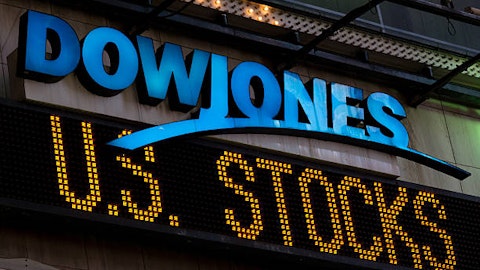American Express Company (NYSE:AXP) Q1 2023 Earnings Call Transcript April 20, 2023
American Express Company misses on earnings expectations. Reported EPS is $2.4 EPS, expectations were $2.66.
Operator Ladies and gentlemen, thank you for standing by. Welcome to the American Express Q1 2023 Earnings Call. At this time all participants are in a listen-only mode. Later we will conduct a question-and-answer session. [Operator Instructions] As a reminder, today’s call is being recorded.I would now like to turn the conference over to our host, Head of Investor Relations, Ms. Kerri Bernstein. Please go ahead.Kerri Bernstein Thank you, Donna, and thank you all for joining today’s call. As a reminder, before we begin, today’s discussion contains forward-looking statements about the company’s future business and financial performance. These are based on management’s current expectations and are subject to risks and uncertainties. Factors that could cause actual results to differ materially from these statements are included in today’s presentation slides and in our reports on file with the SEC.The discussion today also contains non-GAAP financial measures.
The comparable GAAP financial measures are included in this quarter’s earnings materials as well as the earnings materials for the prior periods we discussed. All of these are posted on our website at ir.americanexpress.com. We’ll begin today with Steve Squeri, Chairman and CEO, who will start with some remarks about the company’s progress and results; and then Jeff Campbell, Chief Financial Officer, will provide a more detailed review of our financial performance. After that, we’ll move to a Q&A session on the results with both Steve and Jeff.With that, let me turn it over to Steve.Steve Squeri Thanks, Kerri. Good morning, everyone, and thanks for joining us today on our first quarter earnings call. Back in January, we laid out our guidance for 2023 of 15% to 17% revenue growth and double-digit earnings per share growth.
Our first quarter results are tracking to this full year guidance. Revenues were a record $14.3 billion in the quarter, up 22%, which is well above our full year expectations. Stronger spending growth outside the U.S. and in T&E offset some softness in U.S. small business spending. EPS came in a bit higher than our original plan expectation. Our plan calls for quarterly EPS to grow sequentially through the year as our revenue growth continues.Billed business was up 16% globally year-over-year on an FX-adjusted basis. T&E spending was up 39% year-over-year on an FX adjusted basis due to the grow over effect – due to grow over benefit from the impact of the Omicron variant in last year’s results. We saw strong demand across all T&E categories and customer types.
Spending at restaurants continues to be a bright spot with growth accelerating to 28% on an FX adjusted basis year-over-year. In fact, March was a record month for reservations booked through our Resy platform. The platform now has more than 40 million users globally, an increase of 5 million in the last six months.Consumer travel demand also remains high with Q1 bookings through our consumer travel business reaching their highest levels since pre-pandemic. As you’ll recall, we reorganized our international business last year, bringing together our consumer, small business and large corporate management teams outside the U.S. to increase agility, scale and efficiency and accelerate our growth. Our international issuing businesses were the fastest growing before the pandemic, and we’re seeing a return to those trends.
International Card Services billings continued to accelerate in the quarter, up 29% on an FX adjusted basis. Results were driven by robust growth in T&E spending, which increased 58% year-over-year on an FX adjusted basis.We also saw continued momentum in card acquisitions with 3.4 million new cards acquired in the quarter. U.S. Consumer Platinum and Gold Business Platinum and Delta co-brand account acquisitions all reached record levels. Notably, over 70% of the new accounts acquired globally in the quarter are on fee-based products. As we noted for some time, Millennial and Gen Z consumers are driving our growth in billings and acquisitions of premium fee-based products. More than 60% of consumer new accounts acquired globally came from Millennial and Gen Z.
These customers also continue to contribute the highest growth in billed business among all age cohorts in the U.S., up 28% in the quarter.On credit, our metrics remain best-in-class, supported by the premium nature of our customer base, our strong risk management capabilities and the thoughtful underwriting actions we’ve taken on an ongoing basis. Our customers have been resilient thus far in the face of slower growth and higher inflation economic environment. While the near-term economic outlook is mixed, our customers’ spending and credit performance to date, along with the continued strong demand for our products from high-quality new customers, reinforces our confidence in our ability to achieve our long-term aspirations. Our capital, funding and liquidity positions are strong and we continue to have significant flexibility to maintain a strong balance sheet in periods of uncertain [indiscernible].As you know, we run our company for the long-term.

We have a strategy in place to deal with swings in the economy, which has enabled us to be successful in navigating through the pandemic, the initial recovery period and the current environment of elevated inflation and higher interest rates. Through it all, we’ve continued to attract and retain high-quality customers and our strategic investments have resulted in the momentum we’ve seen throughout last year and into 2023. We feel good about the decisions we’re making around growth, risk management and the economic environment. Our key metrics are strong. The market opportunities we see in our core businesses are plentiful. And our strategy of investing in value proposition innovations, customer acquisitions and global merchant coverage continues to drive our growth.Based on our performance to date, we are reaffirming our full year guidance of delivering between 15% and 17% revenue growth and earnings per share of between $11 and $11.40.
We remain committed to focusing on achieving our aspiration of delivering sustainable revenue growth greater than 10% and mid-teens EPS growth as we get to a more steady-state macro environment.Thank you, and now I’ll turn it over to Jeff.Jeff Campbell Well, thanks, Steve, and good morning, everyone. It’s good to be here to talk about our first quarter results, which are tracking in line with the guidance we gave for the full year and reflect steady progress against our long-term growth aspirations. Starting with our summary financials on Slide 2, our first quarter revenues were $14.3 billion, reaching a record high for the fourth straight quarter, up 23% on an FX adjusted basis. This revenue momentum drove reported net income of $1.8 billion and earnings per share of $2.40.
Given we had a sizable credit reserve release of pandemic-driven reserves in the first quarter of last year; we’ve also included pretax pre-provision income as the supplemental disclosure again this quarter. On this basis, pretax pre-provision income was $3.2 billion, up 20% versus the same time period last year, reflecting the growth momentum in our underlying earnings.So now let’s get into a more detailed look at our results, which in our spend-centric business model always begins with a look at volumes, which you see on Slides 3 through 7. Total network volumes and billed business were both up 16% year-over-year in the first quarter on an FX adjusted basis. Given that most of our spending categories have fully recovered versus pre-pandemic levels, we saw the more stable growth rates we expected this quarter with first quarter billed business growth of 16%, just above last quarter’s growth of 15%.
As Steve noted earlier, we did see particularly strong growth in travel and entertainment spending in Q1 of 39%, driven by continued demand for travel and dining experiences. As expected, this growth rate was elevated early in the quarter as we lapped the impact of Omicron in January of the prior year. So I would expect to see growth moderate moving forward, but to remain high given the strong demand we are seeing across geographies, customer types and T&E categories.We also saw solid growth in goods and services spending for the quarter, up 9% year-over-year. I would note that we did see this growth rate slow sequentially in the U.S. for both SME and consumer as we went through the quarter. So we are continuing to monitor these spending trends.
That said, overall billed business reached a record level in the month of March, and our largest segment, U.S. Consumer, grew billings 16% in the first quarter, accelerating a bit above last quarter’s growth. Millennial and Gen Z customers again drove our highest billed business growth within this segment with their spending growing 28% year-over-year this quarter.Turning to Commercial Services. We saw a year-over-year growth of 10% overall. U.S. SME growth came in at just 6% this quarter, but was somewhat offset by really good growth in U.S. large and global corporates, up 34% year-over-year. And lastly, you see our highest growth in International Card Services. We are seeing the early benefits of the organizational changes we announced last year start to play out demonstrated by strong growth across geographies and customer types.
Spending from international consumer and international SME and large corporate customers, who were among our fastest-growing pre-pandemic, grew 27% and 34% year-over-year, respectively. International Card Services travel and entertainment growth was especially robust at 58% for the quarter. This segment is still in a recovery mode given it started its pandemic recovery later than other segments. Overall, our spending volumes are currently tracking to support our revenue guidance for the year and our long-term aspirations for sustainable growth rates greater than what we were seeing pre-pandemic.Now moving on to Loans and Card Member receivables on Slide 8. We saw year-over-year growth of 25% in our loan balances as well as continued sequential growth.
This growth continues to come mostly from our existing customers, who are rebuilding balances, and as a result, the interest-bearing portion of our loan balances is growing faster than the 25% growth we see in total loans. Specifically, over 70% of this growth in the U.S. is coming from our existing customers. We are pleased with this growth and with the overall lending economics we are generating. That said, looking forward, you may see the growth rate of our loan balances moderate a bit as we progress through 2023, but we would expect it to remain elevated versus pre-pandemic levels.If you then turn to credit and provision on Slides 9 through 11, the high credit quality of our customer base continues to show through in our best-in-class credit performance.
Our card member loans and receivables write-off and delinquency rates remain below pre-pandemic levels, though they did continue to move up this quarter as we expected, which you can see on Slide 9. We view these consolidated write-off and delinquency rates as more comparable to pre-pandemic rates than the individual loans and receivable rates because, as we talked about last quarter, our charge products in many instances now have embedded lending functionality. Going forward, we continue to expect these delinquency and write-off rates to increase over time, but they are likely to remain below pre-pandemic levels in 2023.Turning now to the accounting for this credit performance on Slide 10, the expected increases in delinquency rates combined with the quarter-over-quarter growth in our loan balances resulted in a $320 million reserve build.
This reserve build, combined with net write-offs, drove $1.1 billion of provision expense in the first quarter as we moved past much of the volatility in this line item that CECIL reserve builds the releases caused during the pandemic.As you see on Slide 11, we ended the first quarter with $4.4 billion of reserves representing 2.5% of our total loans and card member receivables. This reserve rate remains about 40 basis points and below the levels we had pre-pandemic or day one CECIL. We expect this reserve rate to continue to increase as we move through 2023, but to remain below pre-pandemic levels.Moving next to revenue on Slide 12, total revenues were up 22% year-over-year in the first quarter or 23% on an FX adjusted basis. Before I get into more details about our largest revenue drivers in the next few slides, I would note that service fees and other revenue was up 34% in the quarter, driven largely by the year-over-year increases in travel-related revenues that accompanied the tremendous demand we’ve seen for travel.As you can see on Slide 13, our largest [indiscernible] line discount revenue grew 17% year-over-year in Q1 on an FX adjusted basis, which similar to spending volumes, growth is just above last quarter’s growth rate.Net card fee revenues were up 23% year-over-year in the first quarter on an FX adjusted basis as you can see on Slide 14.
Growth, which did moderate slightly this quarter as expected from the extremely high level we saw last quarter remains quite strong. This growth continues driven largely by bringing new accounts onto our fee paying products as a result of the investments we’ve made in our premium value propositions. This quarter, we acquired 3.4 million new cards demonstrating the demand we’re seeing, especially for our premium fee-based products.Moving on to Slide 15, you can see that net interest income was up 36% year-over-year, on a FX adjusted basis accelerating versus last quarter, primarily due to the growth in our revolving loan balances. I’d also note that net yield on our card member loans increased 50 basis points sequentially reaching pre-pandemic levels this quarter as our customers increase their revolving balances.
We have been able to increase our net yield while maintaining net right off rates below pre-pandemic levels, expanding our net credit margin.To sum up on revenues, on Slide 16, we’re tracking well against our expectations and looking forward, we still expect to see revenue growth 15% to 17% for the full year of 2023.The revenue momentum we just discussed has been driven by the investments we’ve made. Those investments show up across the expense lines you see on Slide 17. Starting with variable customer engagement expenses, these costs came in at 43% of total revenues in the first quarter, tracking right with our expectation for them to run around 43% of total revenues on a full year basis. On the marketing line, we invested $1.3 billion in the quarter on track with our expectation to have marketing spend that is fairly flat to our full year 2022 expense, $5.5 billion.
We remain focused on driving efficiencies so that our marketing dollars grow far slower than revenues as we did for many years prior to the pandemic.Moving to the bottom of Slide 17 brings us to operating expenses, which were $3.6 billion in the first quarter. There is usually some quarterly volatility in this number and this quarter, for example, we saw a $95 million impact from net mark-to-market losses on our Amex Ventures investment portfolio. But you can see based off our first quarter results that similar to marketing, we are tracking with our expectation for operating expenses to be around $14 billion for the full year. We continue to see operating expenses as a key source of leverage. And moving forward expect to have far less growth in OpEx relative to our high level of revenue growth.Turning next to capital on Slide 18, we ended the first quarter with our CET1 ratio at 10.6% with our target range of 10% to 11%.
I would note that AOCI already flows through our regulatory capital today. So any unrealized gains or losses on our investment portfolio are fully reflected in the 10.6% that I just quoted. I would also point out that we hold only $4 billion of investment securities, most of which are short-dated U.S. treasuries.In the first quarter, we returned $600 million of capital to our shareholders. With our strong capital position, we have both the capacity and the intent to continue to return to shareholders the excess capital we regenerate, while supporting our balance sheet growth.I’d also note that our liquidity position remains extremely strong as we ended the quarter with $41 billion of cash; our highest ever balance, excluding the pandemic period.
We also saw a 10% increase in our deposits this quarter, including the inflows in the weeks following recent volatility in the banking sector.On Slide 25 of the appendix, we have provided a bit more detail on deposits than we typically do, if you’d like to look at some of the numbers.That brings me then to our growth plan and 2023 guidance on Slide 19. For the full year 2023, we are reaffirming our guidance of having revenue growth of 15% to 17% and earnings per share between $11 and $11.40. At this level, year-over-year revenue growth, we expect to see a significant, sequential increase in the amount of revenues as we go through the year. In contrast, our marketing and operating expenses were already more in line with the run rate for the year in the first quarter.
There is always some quarter-to-quarter volatility.So the simple math then gets you to the sequential growth in our underlying earnings consistent with our full-year EPS guidance. There is clearly uncertainty as it relates to the macroeconomic environment. But as Steve discussed, our customers have remained resilient thus far in the phase of the slower growth, higher inflation economic environment. Our outlook is based on the blue-chip macroeconomic consensus, which continues to expect slowing growth, though not a significant recession. In any environment, though we are focused on running the company for the long term.Looking forward, we remain committed to focusing on achieving our aspiration of sustainably delivering revenue growth in excess of 10% and mid-teens EPS growth as we get to a more steady state environment.And with that, I’ll turn the call back over to Kerri to open up the call for your questions.Kerri Bernstein Thank you, Jeff.
And before we open up the line for Q&A, I will ask those in the queue to please limit yourself to just one question. Thank you for your cooperation. And with that, the operator will now open up the line for questions.Operator?
See also 12 Most Advanced Countries in Cybersecurity and 16 Best Places to Live in Florida for Young Adults.
Question-and-Answer Session Operator [Operator Instructions]
Our first question is coming from Sanjay Sakhrani of KBW. Please go ahead.Sanjay Sakhrani Thanks. Good morning. Steve, I think, the number that’s pretty striking is the strong growth among millennials and Gen Z, which seemed like a third of the U.S. spending volumes. I’ve heard some worry about like this cohort because they are relatively new to credit, but obviously it seems like the spending remains quite strong. So I’m just curious sort of how you are seeing things trend for them whether or not you feel like there is more risk or less risk.
And then, maybe Jeff, you can collaborate a little bit more on the weaker spending trends that you saw in March. Thanks.Steve Squeri Yes, I think, that well, Jeff can elaborate a little bit more, but March was a record spending month for us. Overall, it was the highest month we ever had in the history of the company. So feel free to elaborate on that, Jeff. But millennials have been a big part of our growth story, and if you go back pre-pandemic, they represented about 20% of our billings. Now they represent 30% of our billings, and they are growing at, I mean, last quarter they grew at 30%, this quarter they grew at 28%. And we’re acquiring 60% of our new cards acquired.I think from risk perspective, they play out much like low tenure plays out.
And so we really have not seen anything different with millennials than we have seen with any of our other card acquisitions. And so, like anything you need to watch, you watch that, but right now we don’t have any concerns with that.And the other thing that I will point out is that this whole concept of getting more millennials really started with our focus on generational relevance and making sure that our products and services were attractive across an entire cohort. And so that is really working for us as you’ve seen the composition of our base change. And so that gives me a lot of confidence as we move forward that we’re making the right moves from a value proposition perspective and continuing to invest in the right benefits, and we are acquiring the right customers.And as I have said on these calls before we continue to raise the bar in the phase of an uncertain economic environment, we continue to read the bar on who we are acquiring.The last point that I will make, because I think, it’s really relevant, and stay with me on this for a second.
If you go back to 2018 and look at all the cards that we acquired in 2018 and looked at what the first quarter spending was in 2019, and you did the same thing in 2022 and looked at what the first quarter spending was in 2023, we are 50% higher, meaning, we are acquiring higher spending card members. And so I think the teams have done a phenomenal job of really sort of getting through the quarter [ph] and getting not only more card members, but getting card members that spend, getting card members that are paying fees and getting card members that will be with us for a long time.So that’s a – it’s a long sort of answer, but I think it’s really is relevant to what you were talking about in terms of millennials because I think that gives you a pretty good picture of just how we are looking at that segment and just how that segment is performing and how we believe it will continue to perform.
So you want to talk about March, Jeff?Jeff Campbell Well, the only thing I would add is, we’re just trying to be transparent, Sanjay. I think a lot of people describe the current economic environment as mixed. And so March was our strongest month ever across the globe in terms of volumes as a company. In the U.S., spending customer types on Travel and Entertainment is really strong. But you did see in Goods and Services as you went from January to February to March, spending slow a little bit the growth rate sequentially. On the other hand, you’ve also got to sort through how does Omicron last January, February fit into that. So, we’re just trying to be transparent about sorting through all the mixed signals. But I think we come back to our customers overall have shown great resilience in the face of all the mixed signals in the economy, and that’s what we’re running the company on.Operator Thank you.





